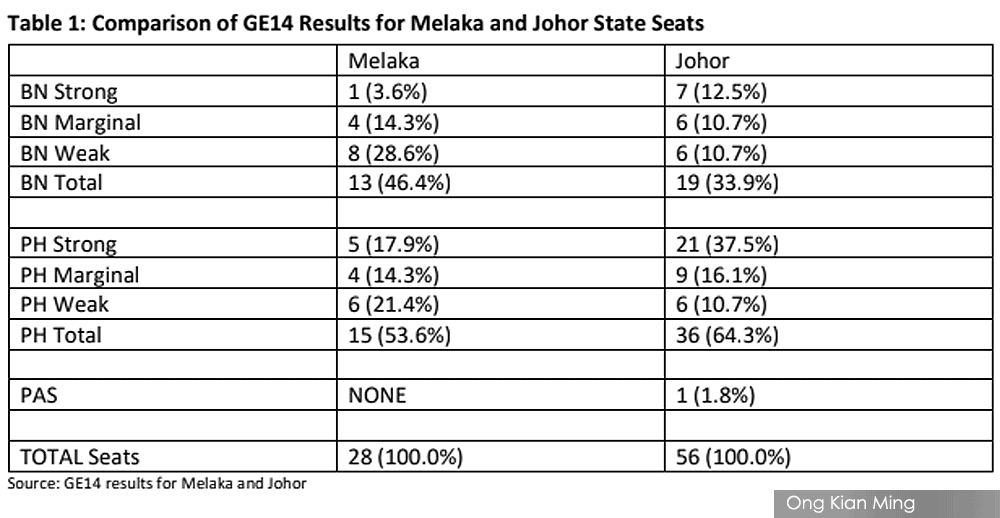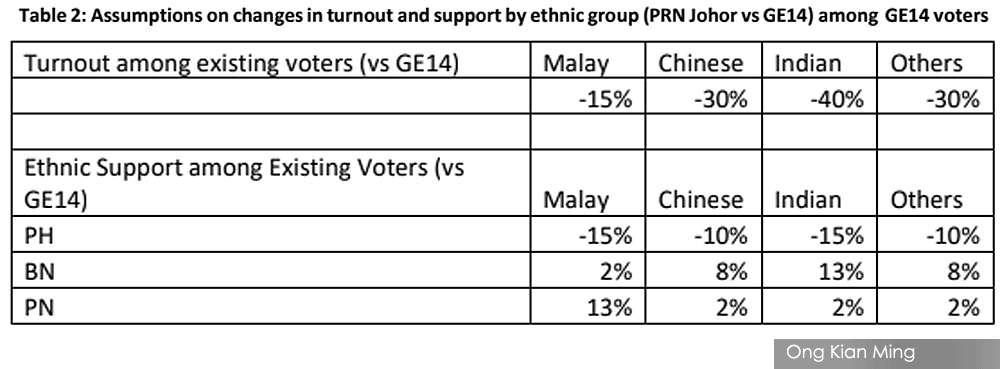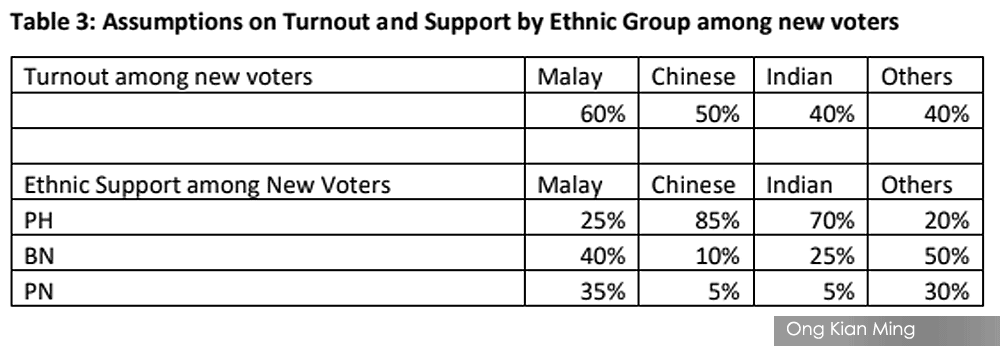MP SPEAKS | Every vote counts in Johor polls
MP SPEAKS | There are some Umno leaders who have been publicly declaring that the polls are a “done deal” and BN will easily win control of the state government and has a good chance of winning more than 37 out of 56 state seats (a two-thirds majority). According to these leaders, a repeat of the results of the Malacca polls is very likely.
The overconfidence on BN’s part is misplaced for a few reasons. Firstly, the situation after GE14 in Johor was very different from Malacca. In Malacca, Pakatan Harapan only enjoyed a two-seat majority (15 vs 13) against BN in the 28-seat state assembly. In Johor, Harapan enjoyed a comfortable 17-seat majority (37 vs 19) against BN in the 56-seat state assembly.
Furthermore, the percentage of seats which were won by Harapan by more than 55 percent of the vote was much higher in Johor than in Malacca (five seats or 17.9 percent in Malacca compared to 21 seats or 37.5 percent in Johor, see Table 1 below).
In addition, many of the seats which Harapan won with comfortable majorities were either non-Malay-majority seats or Malay-majority seats with a significant percentage of non-Malay voters. Even with a reduced turnout among non-Malay voters, it won’t be as easy for BN to win back a significant number of these “Harapan-strong” seats.

At the same time, BN has to deal with a new challenge in the Johor state election which it did not have to face in Malacca - namely the huge increase in the number of voters due to Undi 18 and automatic voter registration. Specifically, the addition of approximately 780,000 voters, representing a 42 percent increase in the 1.8 million voters from GE14 in the Johor electoral roll.
Many of these voters are not aligned to any party and as such, BN cannot make a confident claim that it can easily win a majority of these mostly young and first-time voters.
Having spent some time campaigning in the Johor Bahru area over the past week, it is clear that the economy here is still very much affected by the border closure with Singapore. Many shops are still closed or up for rental and the number of customers in shops which are open are probably 30 percent of total capacity at most. I am sure that other areas in Johor are similarly affected but perhaps not as much as Johor Bahru.
Some of the negative backlash from the poor Covid-19 management either at the federal or at the state level will fall somewhat on BN as well as on Perikatan Nasional (PN), though the exact attribution of blame for which coalition will depend on the area in question and also the performance of the elected representative in those areas, whether from BN, PN or Harapan. This means the “mass exodus” of voters back to BN is not likely.
Projecting Johor polls results – assumptions and caveats
It is not easy to come up with a comprehensive model to predict the likely seat by seat outcomes for the Johor state election because there are many variables that are hard to estimate, such as the turnout rate for existing and also new voters.
Nonetheless, I will try to project the results by using certain assumptions about the turnout and support by ethnic groups for the three major coalitions among existing voters and also first-time voters (Undi 18 and automatic voter registration).

I assume that the turnout rate among the Malay, Chinese and Indian voters will fall by 15 percent, 30 percent and 40 percent respectively.
The Chinese voter turnout rate will experience a larger fall compared to the Malay voters because more of them are working in Singapore currently and are not likely to come back to vote. Some of the Indian voters are working in Singapore but many others may also feel disenfranchised and disappointed with the political process, more so than the other voters.
I assume that the Malay, Chinese and Indian support for Harapan will fall by 15 percent, 10 percent and 15 percent respectively. The fall in the Malay support is due to PN, specifically Bersatu president Muhyiddin Yassin’s influence in Johor, taking away Malay support from Harapan.
From the election results in Malacca, we can see that the loss in Malay support experienced by Harapan largely went to PN instead of Umno and we can assume the same trend in Johor.
We did not observe a big swing in the Chinese support for Harapan in Malacca among the Chinese voters who turned out to vote and despite the rhetoric of MCA to say that Chinese voters are coming back to the BN in droves, I don’t think this is likely.
The Indian vote swing back to BN, especially in areas with a larger percentage of Indians in the B40 community, is likely because of the use of traditional BN strategies during elections but it will not be to the pre-GE14 levels that perhaps BN is expecting.

For the first time, the number of voters is almost 780,000. I assume that voter turnout will be the highest among the Malays (60 percent) followed by the Chinese (50 percent) followed by the Indians and other voters (40 percent).
Among this group of first-time voters, BN cannot assume that it will win more than 50 percent of their votes, especially and including the Malay voters. No doubt, I have heard that BN is running a good ground game in organising futsal and badminton competitions and even making a foray into e-sports to attract the youth vote.
But Harapan also has a good social media campaign going and together with Muda’s appeal and outreach among the young, support among new voters will likely be split among the three coalitions.
I assume that Harapan will get approximately 25 percent of the Malay vote, especially in the urban areas, and also win 85 percent of the Chinese and 70 percent of the Indian first-time voters. BN will win 40 percent of the Malay vote, 25 percent of the Indian vote and only 10 percent of the Chinese vote. PN will make a strong push for the Malay vote against BN, especially in the semi-rural and rural areas, by capturing 35 percent of the Malay vote but will find it hard to win even 5 percent of the Chinese and Indian vote.
I want to note a few big caveats about my assumptions:
They do not take into account variations from seat to seat. For some seats, Harapan’s vote share among the Malay voters may be higher because of the good service record of Harapan incumbents, especially over the last two years during the pandemic.
They do not take into account specific areas where certain coalitions may be stronger because of local leadership factors e.g. PN is likely to make a strong showing in the two state seats of N7 Bukit Kepong and N8 Bukit Pasir, both of which are located in the parliamentary constituency of former prime minister Muhyiddin, Pagoh. There will be a few other areas where local PN/Bersatu leadership will have a much stronger showing especially among the Malay voters compared to the state-wide average.
I assume that the influence of Pejuang and Warisan will be relatively limited, especially in their ability to take away significant vote share from Harapan or PN.
I assume that in seats where Muda is contesting, they will get the same level of estimated support as Harapan (with the exception of Larkin where both PKR and Muda are contesting).
Projected results
With these assumptions and caveats in mind, what are my projected results for the Johor polls? My estimates show that BN will win 27 seats (two short of a bare majority), Harapan will win 22 seats, PN will win 1 seat and 6 seats are too close to call.
Of course, some of the Harapan seats may end up as PN seats if the Malay swing to PN is significant enough. What this means is that the contest is still too close to call and voter turnout will end up determining the final outcome of the Johor state elections. This means that “every vote counts” in the fight to determine the next government of Johor and perhaps the future of Malaysian politics in the next three to 12 months.
ONG KIAN MING is Bangi MP.
The views expressed here are those of the author/contributor and do not necessarily represent the views of Malaysiakini.
RM12.50 / month
- Unlimited access to award-winning journalism
- Comment and share your opinions on all our articles
- Gift interesting stories to your friends
- Tax deductable
